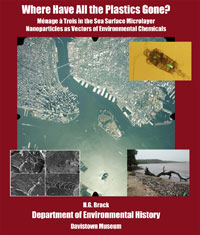
 Where Have All the Plastics Gone?: Menage a Trois in the Sea Surface Microlayer: Nanoparticles as Vectors of Environmental Chemicals
Where Have All the Plastics Gone?: Menage a Trois in the Sea Surface Microlayer: Nanoparticles as Vectors of Environmental Chemicals
H.G. Brack
1st edition, 2015
The subject of this publication is nanoparticles, including plastic nanoparticles, as vectors of environmental chemicals and their movement through the biosphere. The annotated bibliography which follows the essays provides a topic-specific journey through the world of nanoparticles and nanotechnology and their health physics significance. The hemispheric water cycle provides the context for the movement of environmental chemicals in all trophic levels of the biosphere. The tendency of invisible nanoparticles including plastic nanoparticles (PNP) to sorb environmental chemicals and then be ingested by microbiota constitutes the ménage à trois that is an overlooked pathway of human exposure to environmental chemicals. The growing presence of environmental chemicals in the hemispheric water cycle is only one component of the imposition of human ecosystems on natural ecosystems, and is manifested in a worldwide water crisis with vast environmental, social, and political ramifications. The omnipresence of environmental chemicals in the global water cycle can be expressed by the metaphor of the biosphere as a bowl of soup. More specifically, organochlorine soup is an appropriate description of the current status of the global water cycle. Associated ingredients include organophosphates, phthalates, BPA, hormone disrupting chemicals (HDC), obesogens, anthropogenic radioactivity, and remobilized naturally occurring ecotoxins, such as methylmercury. Most of these organochlorine soup ingredients were not constituents of the global water cycle before 1940. The research cited in this annotated bibliography provides commentary on an overlooked component of the impact of our plastic lifestyles on vulnerable finite natural ecosystems.
Softcover, 8" x 10"
$15.00
Available on Amazon.com